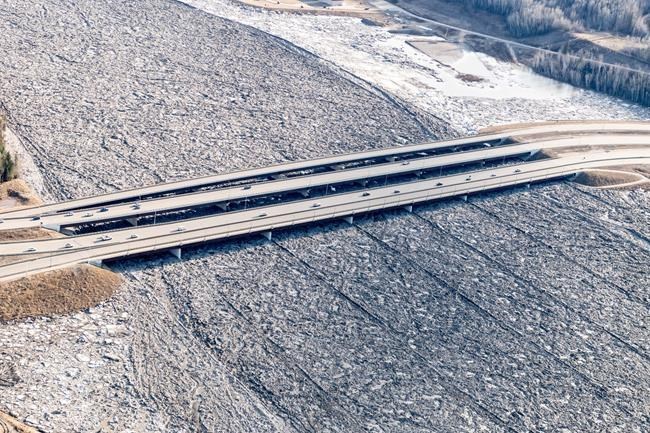FORT MCMURRAY, Alta. — An ice jam had shrunk to almost half its size Thursday after causing major flooding earlier in the week that forced 13,000 people from their homes in Fort McMurray.
Officials said the blockage on the Athabasca River was about 13 kilometres long — down from 25 kilometres two days before — and water levels had dropped significantly on the Athabasca and Clearwater rivers in and around the northern Alberta city.
Environment Minister Jason Nixon said the improvement was allowing municipal officials to start planning for the return of evacuees.
"With the river ice continuing to melt and flow downstream, municipal authorities are now in the planning stages for re-entry," Nixon said at a news conference.
"It's important to remember that we still have flood water in these communities and our first priority is to protect the communities threatened by flooding."
The Fort McKay First Nation, about 60 kilometres north of the city, reported a death related to the flooding.
RCMP said officers were called to help two people stranded on the Athabasca River, northeast of the hamlet of Fort McKay. The two men had been on ATVs on a trail when water levels surged. They were able to hold on to a log until they could be rescued, said police.
Both were taken to hospital in Fort McMurray, but the older man died. Two women, two children and two dogs were also rescued from a nearby cabin.
Farther north, 450 residents from Fort Vermilion and Tallcree First Nation had to leave earlier this week due to another ice jam on the Peace River.
"The flooding danger in Fort Vermilion has passed, though flood levels do remain in Beaver Ranch," Mackenzie County Reeve Josh Knelsen said Thursday.
He said crews have started assessing the damage and need to ensure the community is safe before anyone is allowed back.
Knelsen said there was no timeline for residents to return, but the county had arranged a bus tour for evacuees to see the damage.
Nixon said the ice jams on the Peace River had released and moved downstream, where there was some flooding at the Little Red River Settlement. The ice jammed again at Garden River, forcing about 800 people out.
That means more than 14,000 residents were out of their homes on Thursday in northern Alberta.
Officials said they were still assessing flood damage in Fort McMurray, which is under a second state of local emergency on top of one declared last month because of the novel coronavirus pandemic.
"This is a one-in-100 year event," said Mayor Don Scott. "There's never been anything like this — and that's combined with the COVID-19 challenges."
At least 1,230 structures have been damaged, he said. That's almost half the number of buildings and homes lost in a wildfire that forced the evacuation of the entire city in May 2016.
The municipality's director of emergency management, Scott Davis, said it will be some time before evacuees can return.
"We are ... working with (Alberta Health Services), public health and RCMP as we determine what areas we can safely populate," Davis said.
"We want to ensure that the critical infrastructure has the ability to withstand a repopulation in a proper manner."
A virtual community townhall was to be held for residents later Thursday to provide an update on the river breakup and flood.
Nixon said a number of provincial conditions must be met before evacuees can return.
"Those conditions include floodwater no longer being an imminent threat, the availability of critical infrastructure and essential services and hazards in the area being secured," he said.
"There is no question that the recovery process in this community will be lengthy."
This report by The Canadian Press was first published April 30, 2020
— By Colette Derworiz in Edmonton
The Canadian Press




